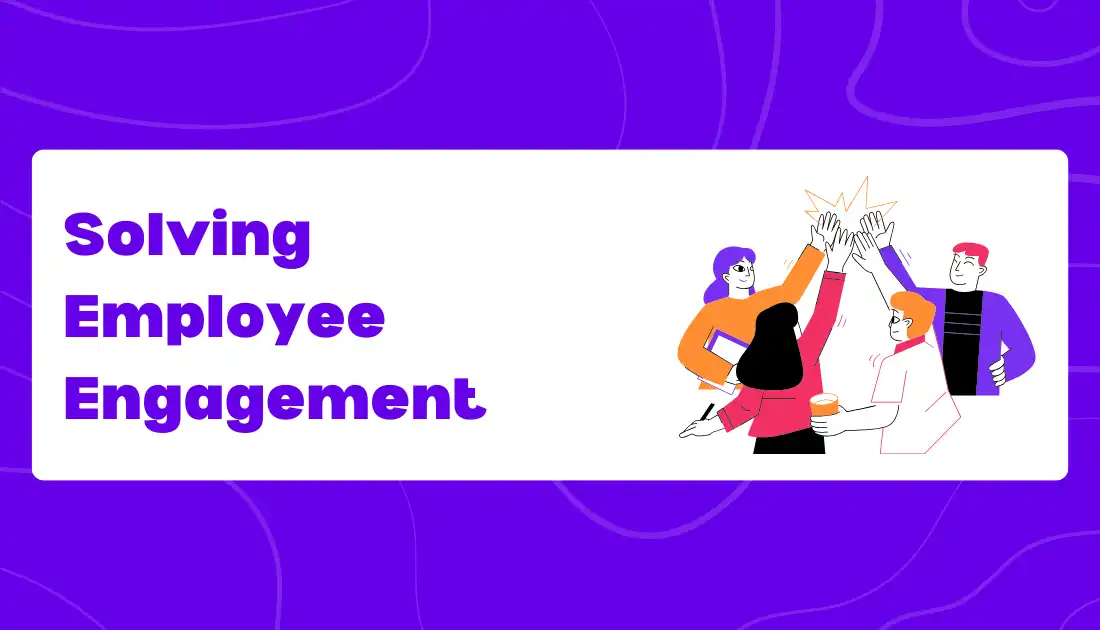Is your workforce truly engaged? Gallup studies of 2022 show employee engagement continues to decline, with only 32% of workers saying they are engaged at work. This lack of engagement stems from feeling undervalued, ineffective leadership, and poor company culture.
Engaged employees are more productive, and loyal, and provide better customer experiences. To boost engagement, focus on open communication, career development, work-life balance, and inclusive company values.
Read on to learn more about diagnosing and treating low engagement.
Key Takeaways
- Rising Low Engagement: A significant portion of the workforce feels undervalued and disengaged, impacting productivity and workplace morale.
- Importance of Recognition and Growth: Effective employee engagement stems from acknowledging achievements and providing growth opportunities.
- Overcoming Barriers: Address challenges like lack of clarity, cynicism, and poor management decisions to enhance engagement.
- Role of Project Management Tools: PM tools like Onethread aid in boosting engagement through efficient task management, goal tracking, and fostering open communication, aligning with key engagement strategies.
Try Onethread
Experience Onethread full potential, with all its features unlocked. Sign up now to start your 14-day free trial!
What is Employee Engagement?
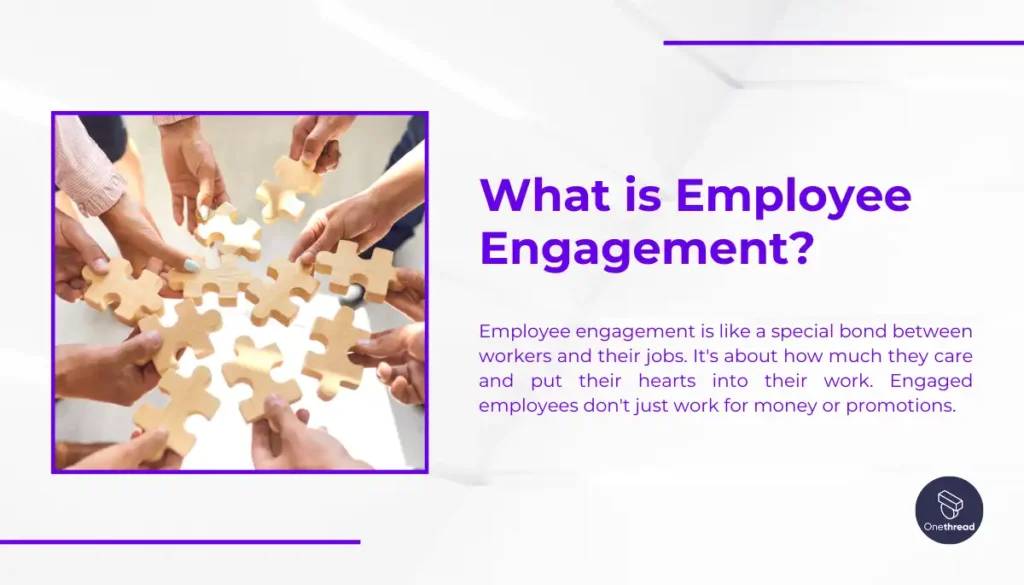
Employee engagement is like a special bond between workers and their jobs. It’s about how much they care and put their hearts into their work. Engaged employees don’t just work for money or promotions.
They really believe in what they’re doing and want to help their company succeed. They feel connected in three main ways: to the work they do, the people they work with, and the whole company.
When employees are engaged, they do their best work, help make a positive workplace, and feel good about what they’re doing. This special connection is built on trust and good communication. It makes a big difference in how well a company does and how happy its workers are.
12 Elements of Engagement
The 12 elements of employee engagement, often referred to as the Gallup Q12, are a set of questions developed by Gallup. These questions are designed to measure the most important aspects of employee engagement in the workplace. Here they are:
- Know What’s Expected: Employees should clearly understand their roles and responsibilities.
- Materials and Equipment: Employees need the right materials and equipment to do their work right.
- Opportunity to Do Best: Employees should be given opportunities to do what they are best at every day.
- Recognition and Praise: Regular acknowledgment and appreciation for good work.
- Someone Cares: Feeling that someone at work genuinely cares about them as an individual.
- Encouragement to Develop: Opportunities and support for personal and professional growth.
- Opinions Count: Employees’ opinions are valued and considered in the workplace.
- Mission and Purpose: Understanding how their work contributes to the company’s mission and purpose.
- Coworkers Committed to Quality: Working with colleagues who are equally committed to producing quality work.
- Best Friend at Work: Having a close friend in the workplace.
- Talking About Progress: Regular conversations about employees’ progress and development.
- Opportunities to Learn and Grow: Access to new learning and growth opportunities within the company.
These elements are key to fostering a highly engaged and productive workforce.
Benefits of Employee Engagement
Employee engagement brings numerous benefits to an organization, enhancing both performance and workplace culture. Here are the key advantages:
- Increased Productivity: Engaged employees are more motivated and efficient, significantly boosting productivity.
- Higher Employee Retention: Engagement leads to higher job satisfaction, which reduces turnover rates and recruitment costs.
- Improved Quality of Work: Engaged employees take pride in their work, leading to higher quality outputs and fewer errors.
- Enhanced Customer Satisfaction: Engaged employees are more likely to provide excellent customer service, improving customer loyalty and satisfaction.
- Positive Workplace Atmosphere: High levels of engagement contribute to a positive and collaborative work environment.
- Greater Innovation: Engaged employees are more creative and open to sharing innovative ideas, driving the company forward.
- Better Company Reputation: A highly engaged workforce enhances the company’s reputation as a desirable place to work.
- Improved Financial Performance: The combination of higher productivity, better retention, and enhanced customer satisfaction leads to stronger financial performance.
- Resilience in Challenging Times: Engaged employees are more committed to the company’s goals and are better equipped to handle changes and challenges.
Focusing on employee engagement is a strategic approach that yields long-term benefits for both employees and the organization.
Current State of Employee Engagement
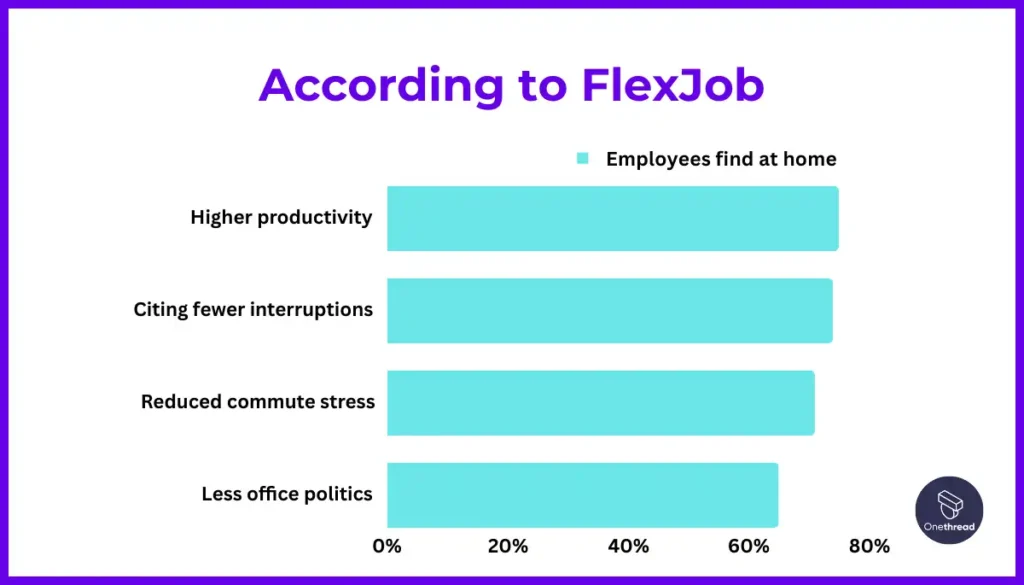
Imagine you’re on a team, everyone’s excited, and you’re feeling like you’re doing something important. That’s what employee engagement is all about, and guess what? It’s on the rise! According to Gallup In 2022, more workers worldwide than ever before felt that way, with engagement reaching a record high of 23%.
This means more people are finding meaning in their jobs and feeling connected to their colleagues, managers, and bosses. That’s awesome!
In 2023, employee engagement trends focus on remote work adaptability, mental health support, personalized growth opportunities, and leveraging technology like Onethread for better communication and collaboration in diverse workplaces.
Try Onethread
Experience Onethread full potential, with all its features unlocked. Sign up now to start your 14-day free trial!
According to FlexJob: 75% of employees find higher productivity at home, citing fewer interruptions (74%), reduced commute stress (71%), and less office politics (65%).
Bad News:
Nearly 60% of employees are just going through the motions. They’re physically there but mentally checked out, a problem known as “quiet quitting.” This disengagement is costing the global economy a staggering $8.8 trillion!
Low employee engagement scores indicate dissatisfaction, highlighting challenges like workplace distractions, insufficient recognition, and a lack of meaningful growth opportunities.
What’s the Deal?
Work stress is a big factor. 44% of employees reported feeling stressed, often due to unsupportive managers.
But there’s hope!
Employees are eager for engaging jobs that offer not just good pay but also well-being, learning, and growth opportunities. Job satisfaction matters more than the work location, whether it’s remote or in-person.
So what can we do?
Businesses must prioritize employee value and support, focusing on communication, growth opportunities, and well-being. And employees? It’s important to voice your needs for a happier, more engaging work environment. Let’s work together to improve the workplace for all!
What is Low Engagement and Its Impact on the Workplace?
Low engagement is when employees aren’t very excited about their jobs. They do the work, but their hearts aren’t in it. This makes them less productive and can make the workplace less fun for everyone.
Impact of Low Employee Engagement
Low engagement in the workplace can have significant negative effects. Here’s how:
- Decreased Productivity and Innovation: Employees with low engagement don’t feel a strong connection to their work or the company’s goals. This leads to less creativity and fewer innovative ideas, causing the organization to fall behind in a competitive market.
- Poor Customer Service and Satisfaction: Disengaged employees often don’t prioritize customer needs, leading to poorer service and a decline in customer loyalty and retention.
- Higher Turnover Rates: Low engagement can lead to employee burnout and dissatisfaction, causing them to leave the company. This results in high turnover costs for recruiting and training new employees.
- Financial Losses: A single toxic worker can drain $12,000/year from a company. Disengaged employees collectively cost organizations a staggering $500 billion annually, according to research.
- Negative Workplace Culture: Disengagement can spread like a contagion, lowering the overall morale and disrupting workplace harmony. This can create a toxic work environment, driving away engaged employees and making the workplace less inclusive.
- Resistance to Change: Long-term disengaged employees might resist new ideas and changes, leading to stagnation and hindering the company’s growth and adaptation to market changes.
- Impact on Employee Health and Well-being: High levels of disengagement can lead to increased stress and absenteeism, further impacting productivity and workplace morale.
Addressing low engagement is crucial for the health and success of an organization. It’s not just about financial performance but also about creating a positive, productive, and innovative work environment that retains top talent and attracts new employees.
Why Is Employee Engagement Falling Short?
Employee engagement is declining due to ineffective leadership, lack of recognition, poor company culture, insufficient growth opportunities, and an imbalance between work and personal life.
5 Barriers to Employee Engagement
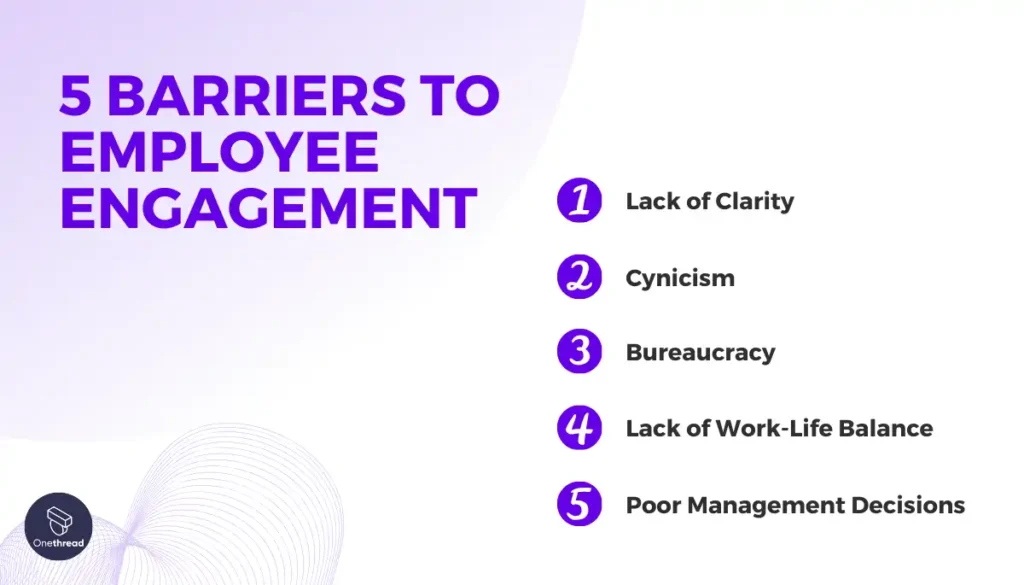
Employee engagement is key to a thriving workplace, but sometimes there are roadblocks. Let’s explore these barriers and how to overcome them.
#1: Lack of Clarity
Many people don’t really understand what employee engagement means. It’s more than just being happy at work; it’s about feeling connected, motivated, and proud of your job and the organization.
- Overcoming It:
- Educate everyone on what true engagement is.
- Use meetings and training to discuss engagement.
- Have one-on-one conversations to reinforce its importance.
#2: Cynicism
Sometimes, employees and managers might be cynical, seeing engagement as just another way to make them work harder for less.
- Overcoming It:
- Show that engagement is not a fad, but a key part of good management.
- Share success stories and the benefits of genuine engagement.
- Commit to making engagement a long-term goal.
#3: Bureaucracy
In some workplaces, strict rules and procedures can make employees feel stuck and unheard, leading to disengagement.
- Overcoming It:
- Challenge unnecessary rules and procedures.
- Create workarounds that make sense.
- Encourage everyone to speak up against inefficient bureaucracy.
#4: Lack of Work-Life Balance
When workers are expected to always put the job first, it can lead to burnout and disengagement.
- Overcoming It:
- Emphasize the importance of a healthy work-life balance.
- Remind employees and managers that rest is essential.
- Encourage breaks and reasonable working hours.
#5: Poor Management Decisions
When managers make decisions based on whims rather than facts, employees can feel undervalued and disengaged.
- Overcoming It:
- Hold managers accountable for their decisions.
- Demand explanations for decisions that seem arbitrary.
- Encourage decision-making based on merit, not favoritism.
Also, these conditions that negatively affect employee engagement include toxic workplace culture, unclear job expectations, lack of feedback and recognition, minimal career development opportunities, poor work-life balance, unsupportive management, and inadequate communication, all of which can lead to decreased motivation and productivity.
Overcoming These Barriers: Quick Tips
- Educate: Make sure everyone knows what engagement really means.
- Demonstrate Success: Show how true engagement benefits everyone.
- Challenge the System: Don’t be afraid to question unnecessary rules.
- Promote Balance: Remind people that life isn’t just about work.
- Demand Accountability: Ensure managers make fair and reasoned decisions.
By tackling these barriers, you can help create a more engaged, motivated, and satisfied workforce. Remember, overcoming these challenges is not just beneficial for the employees but also for the overall health and success of the organization.
Addressing And Overcoming Challenges of Low Employee Engagement.
Let’s talk about how you solve the lack of employee engagement. a key to happy and productive workplaces. With the right steps, you can turn things around!
Challenge 1: Complicated Bureaucracy
Feeling bogged down by paperwork and endless approvals? Streamline processes, use tech to automate tasks, and reduce unnecessary admin work. Give employees more time for what matters! And that’s where Onethread steps in.
Here’s how Onethread helps:
Streamlined Task Management:
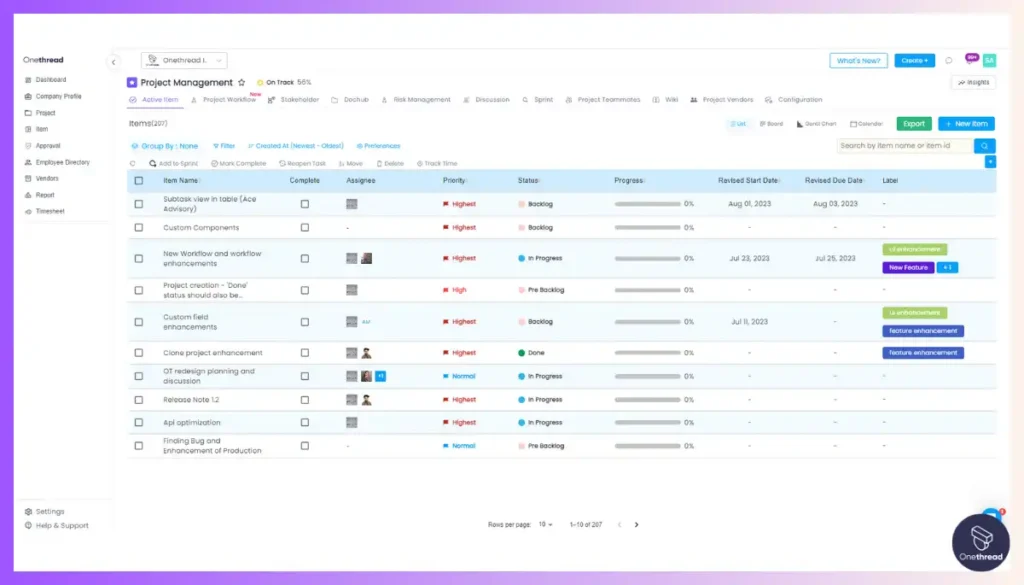
Ditch the paper trails and manage tasks, approvals, and workflows within Onethread’s intuitive platform. No more getting lost in endless emails and documents.
Automated Workflows:
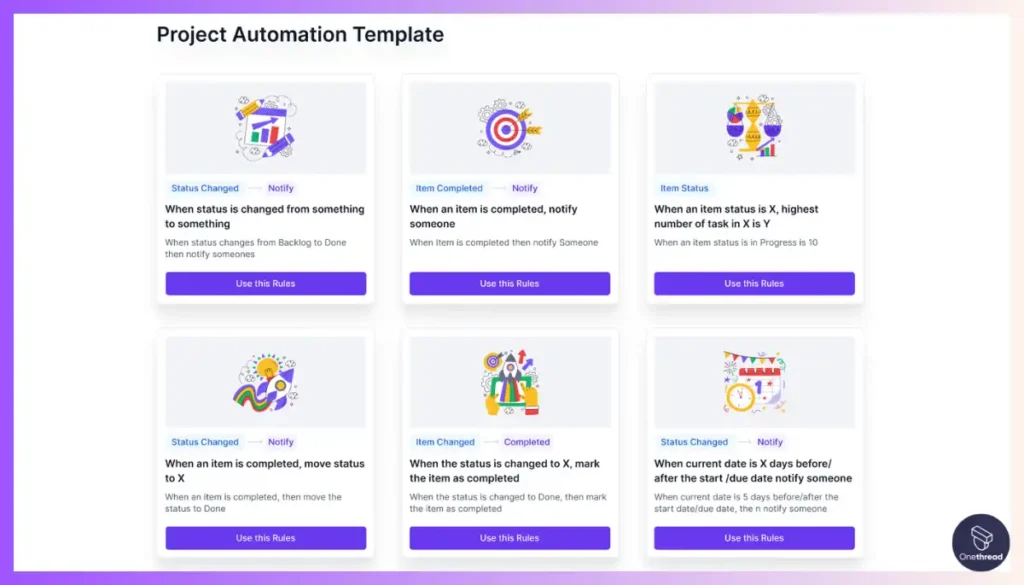
Eliminate repetitive tasks and approvals by setting up automated rules and triggers. Let Onethread handle the heavy lifting while you focus on strategic work.
Centralized Communication:
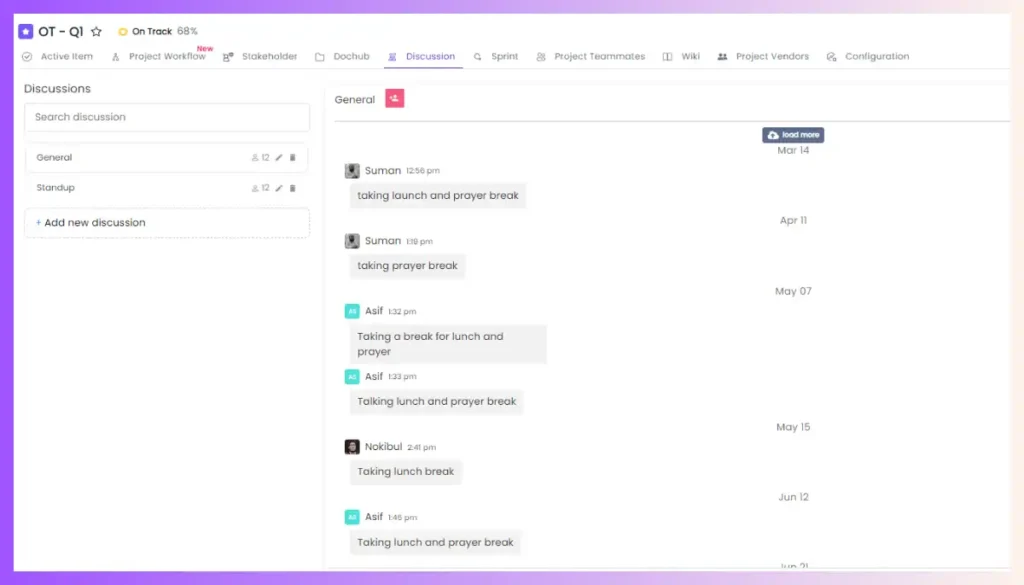
Break down information silos and keep everyone on the same page with real-time discussions and comments within projects. No more chasing approvals or waiting for updates.
Customizable Dashboards:
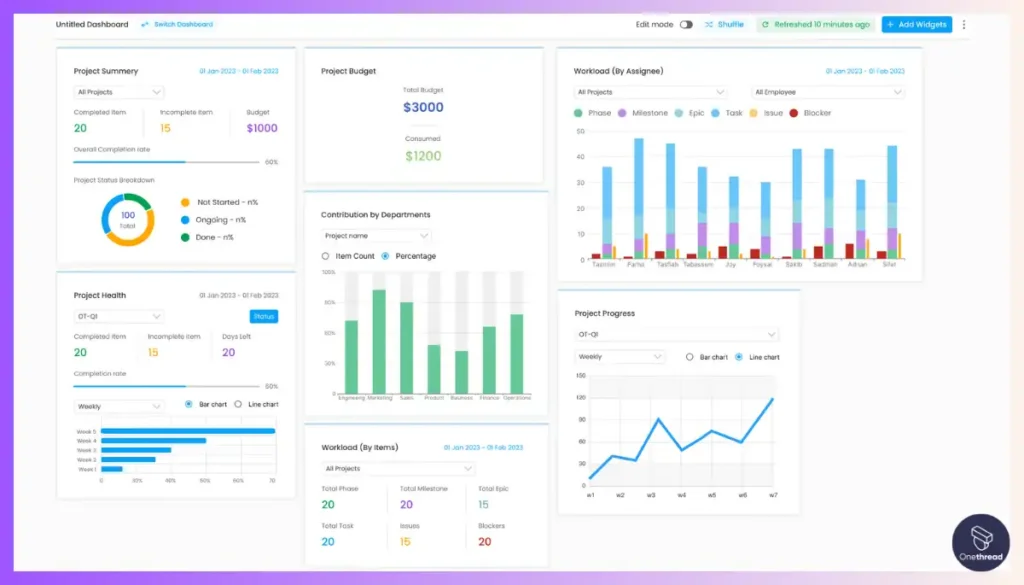
Gain instant insights into project progress and team performance with personalized dashboards showcasing key metrics and reports. Stay informed and data-driven without sifting through spreadsheets.
With Onethread, employees spend less time on administrative burdens and more time on meaningful work, leading to a better work-life balance and increased engagement.
Give your team the gift of time and efficiency with Onethread. Sign up for your free plan today!
Try Onethread
Experience Onethread full potential, with all its features unlocked. Sign up now to start your 14-day free trial!
Challenge 2: Communication Mishaps!
Sometimes, messages get lost in translation. Invest in training for managers on communication and leadership skills. Regular meetings and open communication are key!
Challenge 3: Feeling Like a Lone Wolf!
Do you ever feel like you’re working on an island? Schedule regular one-on-one meetings with your manager to connect, share ideas, and get support. Remember, you’re not alone!
Challenge 4: Stuck in a Dead-End Job
Do you feel like your skills are gathering dust? Invest in your employees’ growth! Offer training, development programs, and career paths. Help them learn and grow!
Challenge 5: Uncertain Future
Keeping secrets from your employees can make them feel unsure. Be open and transparent! Share company goals, involve them in decisions, and build trust.
Challenge 6: Feeling Unseen and Unheard
A simple “thank you” can go a long way! Recognize employees for their hard work, celebrate achievements, and create ways for them to share their voices.
Challenge 7: Feeling Like Nobody Listens
Do your employees feel unheard? Set up channels for feedback, like anonymous surveys or one-on-one sessions. Listen to their concerns and take action!
Extra Tips for Supercharged Engagement:
- Define and share your company’s vision and values. Knowing the “why” behind the work motivates employees!
- Offer regular feedback and recognition. Help employees improve and feel appreciated!
- Encourage teamwork and collaboration. Sharing ideas and working together is fun and productive!
- Empower and involve employees. Give them ownership and a say in decisions!
- Support their well-being and development. Happy and healthy employees are engaged employees!
- Measure and improve engagement regularly. Track progress and adjust strategies to keep things awesome!
Remember, happy and engaged employees are the superheroes of any company! By addressing these challenges and using these tips, you can positively influence workforce engagement levels. where everyone feels valued, motivated, and ready to conquer the world!
16 Key Factors Influencing Employee Engagement in 2024
Employee engagement in 2024 is influenced by job satisfaction, career opportunities, recognition, pay structure, transparency, and more. Detailed insights are below.
1. Strong Leadership
- Impact: Leaders set the tone, build relationships, and promote accountability. Strong leadership fosters trust and well-being, leading to higher engagement.
- How it Works:
- Leaders who connect with employees positively impact tenure and perception.
- Leadership development programs can improve management effectiveness.
2. Caring Organizational Culture
- Impact: A nurturing culture values employees, promotes work-life balance, and fosters engagement. Feeling valued is crucial for employee retention.
- How it Works:
- Welcoming and energetic environments align with engaged employees.
- Recognizing and rewarding performance motivates and stimulates productivity.
3. Meaningful Work
- Impact: Employees engaged in meaningful work find purpose, passion, and job satisfaction. Purpose-driven companies attract and inspire employees.
- How it Works:
- Showcasing impact, offering career development, and improving training can add meaning.
- Employees are more committed when they see the value of their work.
4. Regular Feedback and Recognition
- Impact: Effective communication builds trust and creates a space for valuable feedback. Recognition for contributions is a powerful tool for engagement.
- How it Works:
- Open communication builds trust and encourages feedback.
- Recognizing achievements motivates and fosters loyalty.
5. Professional Growth Opportunities
- Impact: Learning and development initiatives reduce stress, boost productivity, and increase engagement. Cultivating personal growth opportunities is key.
- How it Works:
- Career counseling, training, and mentorship programs support growth.
- Employees who see growth paths are more engaged and motivated.
6. Autonomy and Trust
- Impact: Autonomy motivates employees to excel. Trusting employees builds reciprocal trust and fuels engagement.
- How it Works:
- Micromanagement hinders engagement and reduces motivation.
- Trusting employees empowers them and fosters ownership.
7. Inclusive Work Environment
- Impact: Modern workplaces prioritize inclusivity, honesty, and transparency. Diverse and accepting environments attract and retain talent.
- How it Works:
- Embracing diversity fosters tolerance and understanding.
- Transparency and honesty build trust and encourage open communication.
8. Job Satisfaction
- Impact: Job satisfaction encompasses various aspects like daily tasks, company culture, leadership, and compensation. Satisfied employees are more engaged and productive.
- Key Information:
- Consider factors like work-life balance, career opportunities, and leadership style.
- Satisfied employees are less likely to leave and more likely to recommend the company.
9. Sense of Purpose and Meaning
- Impact: Employees who find their work meaningful are more engaged and committed.
- How it Works:
- Share the company’s mission and values to connect employees to a larger purpose.
- Offer opportunities for personal growth and development to increase meaning.
10. Positive Company Culture
- Impact: A positive culture fosters engagement and attracts talent.
- How it Works:
- Create a welcoming and supportive environment where employees feel valued.
- Recognize and reward positive behaviors and contributions.
11. Equitable Pay Structure
- Impact: Transparency and fairness in compensation contribute to employee satisfaction and engagement.
- How it Works:
- Clearly communicate pay structures and promotion criteria.
- Ensure fair compensation based on performance and experience.
12. Continuous Learning and Development
- Impact: Fostering a culture of learning keeps employees engaged and adaptable.
- How it Works:
- Encourage knowledge sharing and collaboration.
- Offer training and development opportunities to support growth.
13. Diverse and Inclusive Workplace
- Impact: Diversity fosters tolerance, and understanding, and attracts a wider range of talent.
- How it Works:
- Embrace different backgrounds, cultures, and perspectives.
- Create an inclusive environment where everyone feels valued.
14. Transparency and Honesty
- Impact: Open communication builds trust and engagement.
- How it Works:
- Share information openly and honestly, even when it’s difficult.
- Encourage employees to ask questions and express concerns.
15. Mindful Hiring
- Impact: Hiring the right people with the right skills and cultural fit leads to higher engagement and retention.
- How it Works:
- Assess both technical skills and soft skills during the interview process.
- Ensure new hires align with the company culture and values.
16. Employee Involvement and Empowerment
- Impact: Engaging employees in decision-making and providing opportunities for feedback increases ownership and motivation.
- How it Works:
- Encourage employee suggestions and participation in projects.
- Provide clear roles and responses.
These factors can influence employee engagement in the workplace.
Effective Strategies to Enhance Employee Engagement for Better Workplace
Engaging your employees is like adding fuel to a fire – it boosts their energy and commitment. Here’s how to do it effectively!
Building the Engagement Blueprint:
Before diving into specific tactics, let’s lay the groundwork:
- Be Real: Set achievable goals, like reducing turnover by 5%, and remember, perfection takes time.
- Divide and Conquer: Delegate tasks to HR, managers, and employees efficiently with Onethread’s project planning and task management tools. Create an ‘engagement SWAT team’ and monitor their activities through customizable dashboards.
- Stay Flexible: Regularly measure engagement (we’ll talk about how!) and adapt your strategy based on data and feedback. Be open to new ideas!
Now, let’s unleash the engagement powerhouses!
The 5 Cs of Engagement:
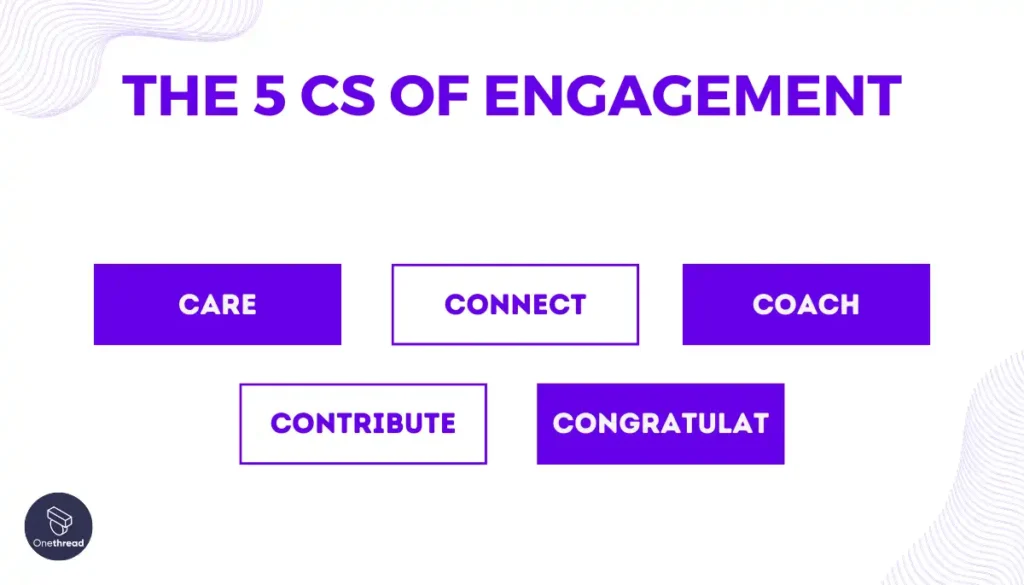
- Care: Show you value their well-being with wellness programs and flexible work options.
- Connect: Foster strong bonds through team-building activities and open communication. Foster bonds through team activities, tracked and managed on Onethread’s platform.
- Coach: Invest in their growth with training and mentorship programs.
- Contribute: Give them the ability to make meaningful decisions and own their projects. Empower employees to own projects, with progress tracked on Onethread’s Kanban Board or Gantt Chart.
- Congratulate: Recognize and celebrate achievements, big or small, to boost morale.
The 4 Es of Engagement:
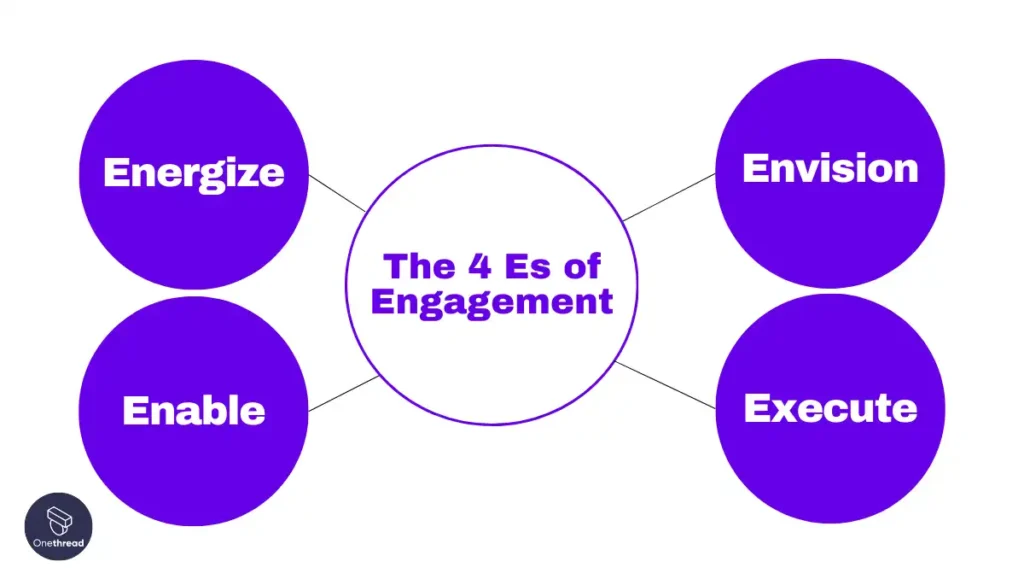
- Energize: Create a vibrant and stimulating work environment. Fun office spaces, anyone?
- Enable: Equip them with the resources and tools they need to succeed. Think cutting-edge tech and clear task guidelines.
- Envision: Share a clear vision and purpose for the company. Help them see how their work fits into the bigger picture.
- Execute: Empower them to take action and achieve goals. Trust them to get things done!
The 3 Ps of Engagement:
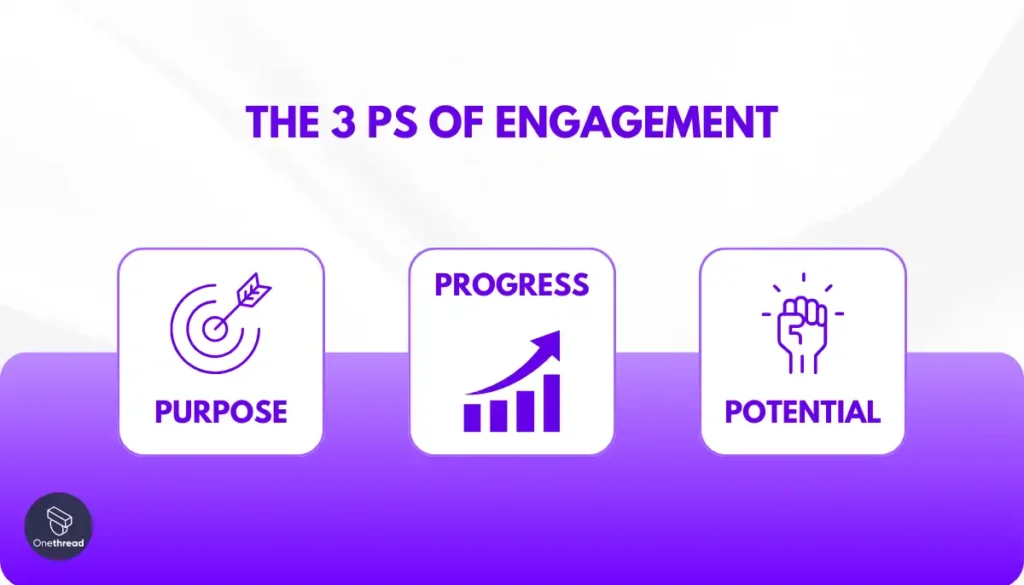
- Purpose: Help them discover their “why” at work. Connect their role to the company’s mission.
- Progress: Offer opportunities for skill development and career growth. Show them they have a future with you.
- Potential: Believe in them and help them unlock their full potential. Watch them soar!
Utilize Onethread to help employees find their purpose, track their progress, and realize their potential through effective project and task management.
Bonus Engagement Boosters:
- Regular feedback and recognition: A pat on the back and constructive criticism go a long way.
- Work-life balance: Help them switch off and recharge for peak performance.
- Open communication: Transparency builds trust and encourages open dialogue.
- Problem-solving activities: Get their brains buzzing and teamwork flowing.
- Learning and development: Invest in their minds and watch them excel.
- Creative activities: Let their imaginations run wild and boost engagement.
- Rewards and perks: Show your appreciation with bonuses, time off, or fun company outings.
- Diversity and inclusion: Embrace everyone’s unique talents and create a welcoming environment.
Remember: Engaged employees are happy, productive, and more likely to stick around. By implementing these strategies, you can create a workplace where everyone feels valued, motivated, and ready to conquer the world, together!
Additional Tips:
- Team-building activities: From trust falls to escape rooms, get creative and have fun!
- Incentives: Reward hard work with bonuses, extra time off, or even just a “thank you” lunch.
- Employee well-being: Offer mental health resources and promote healthy habits.
- Role clarity: Make sure everyone knows their responsibilities and how they contribute.
- AI-powered tools: Use technology to streamline tasks and free up time for meaningful work.
- Positive workplace culture: Encourage teamwork, respect, and open communication.
- Competitive compensation: Pay your people fairly to show you value them.
- Celebrate achievements: Big or small, make a fuss about their successes.
With these strategies and a little heart, you can unlock the incredible power of employee engagement and build a workplace where everyone thrives!
How to Measure and Understanding Engagement?
Measuring employee engagement is like taking the pulse of your workplace. It helps you know how happy and committed your team is.
Engagement Metrics and Examples
According to Gallup, a good engagement score is usually around 70%. This means most of your employees feel connected and enthusiastic about their work.
Measuring Employee Engagement
- Effective Measurement Techniques:
- To really understand how engaged your employees are, you can use surveys, one-on-one interviews, and focus groups. These methods give you a clear picture of what your team thinks and feels.
- Another way is Gallup’s 12-question engagement survey, a mean score of 4.02 suggests a total above 48 signifiying a favorable engagement level.
- Key Performance Indicators (KPIs):
- Some useful KPIs for measuring engagement include turnover rate, absenteeism, productivity levels, and quality of work. These indicators can tell you a lot about how engaged your team is.
Understanding how engaged your employees are is crucial. It helps you make your workplace better and keeps your team happy and productive.
What Is The Employee Engagement Matrix And How It Works?
Employee Engagement Matrix is like a magic grid that sorts your team into 4 groups based on their “engagement level”:
1. Engaged & Enthusiastic: These rockstars are super happy, motivated, and go the extra mile! They love their job, and their team, and are always bringing their A-game.
2. Not Engaged, But Not Disgruntled: They’re just going through the motions, doing their job okay. They might not be unhappy, but they’re not exactly thrilled either.
3. Actively Disengaged: Uh oh! These folks are feeling down, unappreciated, and maybe even thinking of leaving. They’re not contributing their best, and it can bring down the whole team.
4. High Potential: These are the hidden gems! They’re not super engaged yet, but they have the potential to be rock stars with some support and guidance.
So, how does this magic happen? The matrix uses surveys, feedback, and observations to understand your employees’ work experiences and feelings. It then plots them on the grid based on their engagement level and contribution. This helps you see:
- Where your team stands: Are you mostly rockstars, or are there some folks who need a pick-me-up?
- Who needs your attention: It helps you identify the actively disengaged employees so you can support them and turn that frown upside down!
- Where to focus your efforts: Should you celebrate your rockstars, or invest in re-energizing the not-so-engaged bunch?
Remember, the matrix is just a starting point. It helps you identify the issues, but the real magic happens when you take action to address them!
So, is the Employee Engagement Matrix a mind-reading machine? Nope! But it’s a pretty cool tool that can help you understand your team better and create a happier, more productive workplace where everyone feels valued and appreciated.
FAQs
Why is employee engagement decreasing?
Employee engagement is decreasing due to factors like poor management, lack of recognition, insufficient growth opportunities, inadequate work-life balance, and evolving workforce expectations. Technological distractions and changing job market dynamics also contribute to this decrease.
What is the golden rule of engagement?
The golden rule of engagement is to treat employees as you would want to be treated. This means providing respect, clear communication, acknowledgment of their work, opportunities for growth, and a supportive work environment.
Examples of employee engagement in HR.
In HR, examples of employee engagement include recognizing employee achievements, offering career development opportunities, conducting engagement surveys, implementing flexible work policies, and organizing team-building activities to foster a positive work culture.
What is employee engagement in HR?
In HR, employee engagement refers to the strategies and efforts made to ensure employees are committed, motivated, and aligned with the organization’s goals. It involves creating a work environment where employees feel valued, heard, and engaged in their roles.
What is a good employee engagement score?
A good employee engagement score typically falls around 70% or higher. This indicates that a significant majority of employees feel motivated, connected to their work, and are likely to contribute positively to the organization’s goals.
What is the KPI employee engagement score?
A KPI (Key Performance Indicator) employee engagement score is a measurable value that demonstrates how effectively a company is achieving key business objectives through employee engagement. Common KPIs include turnover rate, productivity, absenteeism, and employee satisfaction scores.
Final Thoughts
So, tackling the challenge of low employee engagement is crucial for a thriving workplace.
By focusing on strategies like clear communication, recognition, and work-life balance, and utilizing tools like Onethread for task management and goal tracking, businesses can re-energize their teams.
Enfold these methods to foster a more engaged, productive, and satisfied workforce with Onethread’s support.
Try Onethread
Experience Onethread full potential, with all its features unlocked. Sign up now to start your 14-day free trial!
